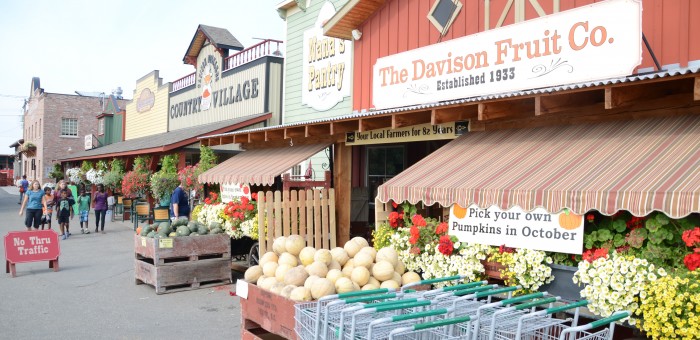Celebrating Innovation in Okanagan’s Agricultural Community
September 1, 2015 By Andrew Weaver Comments are Off Agriculture, Celebrating Local Businesses, Economy, Jobs
BC’s Agricultural Economy
Many of us take for granted the importance of agriculture in the BC economy. When combined with our seafood and food and beverage manufacturing, this so-called agrifoods sector contributes 1.9% of our provincial GDP.
When you look at farm cash receipts (the money received from the sale of agricultural commodities plus any direct program payments made to support or subsidize the agriculture sector), a whopping $2.8 billion flowed into the BC economy in 2013. According to statistics compiled by BC’s Ministry of Agriculture,
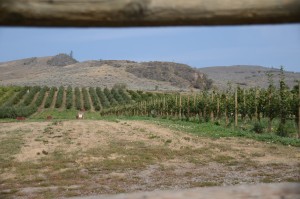 “Total farm cash receipts from the sale of crops, including grains, oilseeds, tree fruits, berries, grapes, field and greenhouse vegetables, floriculture, nursery, forage and other crops, amounted to nearly $1.4 billion in 2013, up 2.7 per cent over 2012 and up 12 per cent over the previous five year average. Total livestock receipts, from the sale of cattle, hogs, poultry, eggs, dairy, honey and other animals and animal products, amounted to more than $1.4 billion, up one per cent over 2012 and up eight per cent over the previous five year average.“
“Total farm cash receipts from the sale of crops, including grains, oilseeds, tree fruits, berries, grapes, field and greenhouse vegetables, floriculture, nursery, forage and other crops, amounted to nearly $1.4 billion in 2013, up 2.7 per cent over 2012 and up 12 per cent over the previous five year average. Total livestock receipts, from the sale of cattle, hogs, poultry, eggs, dairy, honey and other animals and animal products, amounted to more than $1.4 billion, up one per cent over 2012 and up eight per cent over the previous five year average.“
British Columbia also exports its agricultural products around the world. In 2013, agricultural exports amounted to $1.8 billion. Our top five export markets are: 1) United States [76%]; 2) China [4%]; 3) Japan [4%]; 4) Taiwan [2%]; 5) Hong Kong [2%].
What’s more, there were 19,759 farms in British Columbia in 2011, the last year for which census data are available, with 98 % of them being family-controlled farms and with over 54% of their farm operators being 55 years of age or older.
A conversation with Richard Bullock
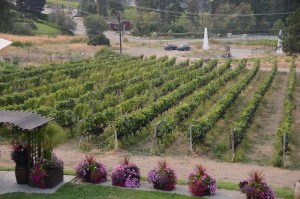 British Columbia is broken up into eight agricultural regions and last week I had the distinct pleasure of touring around the Okanagan region to meet with local civic leaders and business owners to get a sense of the opportunities and challenges facing the Okanagan.
British Columbia is broken up into eight agricultural regions and last week I had the distinct pleasure of touring around the Okanagan region to meet with local civic leaders and business owners to get a sense of the opportunities and challenges facing the Okanagan.
The Okanagan, has long been known for its tree fruit and grape production (and hence its wine industry), so what better place to start the tour than a meeting in Kelowna with, and at the family farm of, Richard Bullock, the past Chair of the Agricultural Land Commission. As the former president of the BC Fruit Growers’ Association, BC Tree Fruits Ltd., and Sun-Rype Products Ltd., and as a former Director of the Canadian Federation of Agriculture and Chair of the British Columbia Farm Industry Review Board, Mr. Bullock is certainly a wealth of information. He provided valuable advice concerning the need for Agricultural policies to be focused on the regional scale that reflect both the type and scale of producer. We also explored the importance of ensuring that water infrastructure, including reservoirs, keep pace with agricultural development as well as means and ways that smaller Okanagan tree fruit growers can compete against large-scale grow operations in other jurisdictions, such as Washington State.
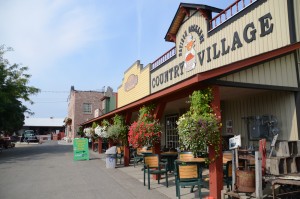 Mr. Bullock was extremely bullish on the agricultural industry in BC stating that he had “never seen the excitement in agriculture before in the last 10 to 15 years”. The numbers back up his sentiments. Agriculture exports increased by 12% in 2014 to $2 billion.
Mr. Bullock was extremely bullish on the agricultural industry in BC stating that he had “never seen the excitement in agriculture before in the last 10 to 15 years”. The numbers back up his sentiments. Agriculture exports increased by 12% in 2014 to $2 billion.
As I noted above, one of the challenges for Okanagan tree fruit growers is keeping fruit prices competitive with the larger growers in the United States and elsewhere. While the low Canadian dollar will surely provide a windfall for BC growers, other local farms have found innovative ways of ensuring that their business is resilient to market fluctuations. One of them, and one that I had the distinct honour of touring, is Davison Orchards Country Village in Vernon.
Davison Orchards Country Village
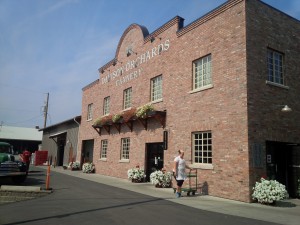 Davison Orchards has been in the Davison family since 1933 and it is now operated by Tom and Tamra Davison (the 3rd generation). Their children (Lance and Laura – the 4th generation) and Tom’s parents (Bob and Dora – the 2nd generation) all work on the farm. Davison orchards offers everything: producing food; capitalizing on tourism opportunities; selling produce and value-added food products (pies, jams etc.) directly to the consumer; offering a location to host private events. What’s more, their on-site café redefines what it means to live on a 100-mile diet as many of the menu items come directly from their farm.
Davison Orchards has been in the Davison family since 1933 and it is now operated by Tom and Tamra Davison (the 3rd generation). Their children (Lance and Laura – the 4th generation) and Tom’s parents (Bob and Dora – the 2nd generation) all work on the farm. Davison orchards offers everything: producing food; capitalizing on tourism opportunities; selling produce and value-added food products (pies, jams etc.) directly to the consumer; offering a location to host private events. What’s more, their on-site café redefines what it means to live on a 100-mile diet as many of the menu items come directly from their farm.
The Davison family is committed to the long-term sustainability of their land and their goal “is to produce fresh, high quality fruit and vegetables in a safe, sustainable and environmentally sensitive manner.” Several hundred thousand people a year visit the Davison orchards which employs upwards of 100 people during the May 1-October 31 season. Everything on the property is sold directly to consumers and the family also supports other farmers in the area by buying their produce and products and subsequently retailing them at their location.
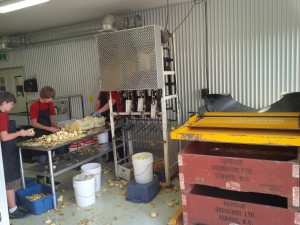 I was extraordinarily impressed at the innovation and creativity exhibited by Tom and Tamra, who gave me the tour of their property. They outlined how people move around from job to job to ensure they can offer stable employment opportunities. For example, the baker becomes the jam maker as the need arises. They also explained to me that it was tough for a small, ~100 acre orchard, to compete in the apple sector when over 100 million 18 kg boxes of apples are picked a year in Washington State just south of the border. But the remaining 1/3 acre of apples left in their orchard certainly allows them to offer visitors first-rate home-baked apple pies.
I was extraordinarily impressed at the innovation and creativity exhibited by Tom and Tamra, who gave me the tour of their property. They outlined how people move around from job to job to ensure they can offer stable employment opportunities. For example, the baker becomes the jam maker as the need arises. They also explained to me that it was tough for a small, ~100 acre orchard, to compete in the apple sector when over 100 million 18 kg boxes of apples are picked a year in Washington State just south of the border. But the remaining 1/3 acre of apples left in their orchard certainly allows them to offer visitors first-rate home-baked apple pies.
 Davison Orchards has become one of the most visited tourist attractions in the area. In fact, Trip Advisor presently lists them as #1 of 35 things to do in Vernon based on 269 reviews earning them a Certificate of Excellence. And their Facebook page is continually updated with what’s in season, ongoing activities and interesting stories about the workings of the orchard.
Davison Orchards has become one of the most visited tourist attractions in the area. In fact, Trip Advisor presently lists them as #1 of 35 things to do in Vernon based on 269 reviews earning them a Certificate of Excellence. And their Facebook page is continually updated with what’s in season, ongoing activities and interesting stories about the workings of the orchard.
Davison orchards has figured out how to thrive through innovation. They’ve accomplished this by not only producing fresh and value added food products that they sell on site, but also through recognizing the tremendous opportunities in the tourism sector. The family-friendly atmosphere they have created means that there are fun things to do for everyone in a family — young and old. It’s a wonderful example of success in the agriculture industry.
Summerhill Pyramid Winery
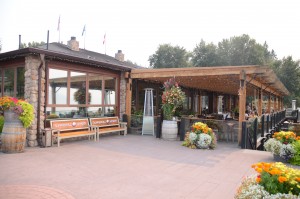 I was also delighted to have the opportunity to be taken around Summerhill Pyramid Winery by its CEO, Ezra Cipes. This allowed me to learn more about the Okanagan’s thriving wine industry.
I was also delighted to have the opportunity to be taken around Summerhill Pyramid Winery by its CEO, Ezra Cipes. This allowed me to learn more about the Okanagan’s thriving wine industry.
Summerhill Pyramid Winery is quite unique. It was Canada’s largest organic wine producer and BC’s first winery to receive (in 2012) Demeter Biodynamic certification. Established in 1991 on land purchased in 1986 by Ezra’s parents Stephen and Wendy Cipes, Summerhill comprises eighty acres of land of which only forty are planted with grapes. As part of the Demeter certification, twenty acres of the Summerhill property were placed under a restrictive covenant with The Land Conservancy of BC to ensure that biodiversity and natural habitat were protected. An additional twenty acres comprise meadows and composting areas.
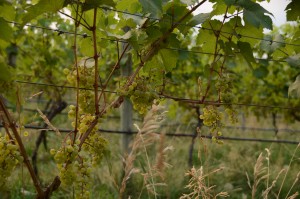 Winemaker Eric von Krosigk co-founded Summerhill in 1991 with the Cipes. He left temporarily in 1994 once the winery was up and running and rejoined Summerhill again in 2006. Ezra took over the day-to-day operations of Summerhill in 2008 and a year later, Summerhill Pyramid Winery was named Canadian Wine Producer of the Year at the International Wine and Competition in London, England. Today, Summerhill produces around 30,000 cases of wine a year, supports another 200 acres of other family-owned vineyards by buying their grapes, and supports around 40 full time employees. In 2014, they wrote paychecks for 270 people.
Winemaker Eric von Krosigk co-founded Summerhill in 1991 with the Cipes. He left temporarily in 1994 once the winery was up and running and rejoined Summerhill again in 2006. Ezra took over the day-to-day operations of Summerhill in 2008 and a year later, Summerhill Pyramid Winery was named Canadian Wine Producer of the Year at the International Wine and Competition in London, England. Today, Summerhill produces around 30,000 cases of wine a year, supports another 200 acres of other family-owned vineyards by buying their grapes, and supports around 40 full time employees. In 2014, they wrote paychecks for 270 people.
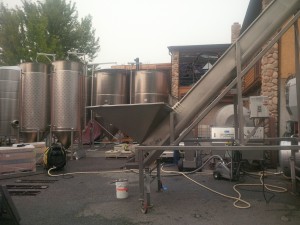 Like Davison Orchards, Summerhill has recognized the incredible opportunities in tourism and through offering value-added services (a restaurant and a location for wedding receptions). Fully 55% of Summerhill’s wine is sold on-site with 2,000 cases passing through their restaurant and wedding reception operations.
Like Davison Orchards, Summerhill has recognized the incredible opportunities in tourism and through offering value-added services (a restaurant and a location for wedding receptions). Fully 55% of Summerhill’s wine is sold on-site with 2,000 cases passing through their restaurant and wedding reception operations.
Summerhill takes tourism seriously. When we arrived at Summerhill Pyramid Winery last Tuesday, the parking lot was full and a bus load of Asian tourists were admiring the beautiful views of Lake Okanagan. They have fully restored a cabin used by one of the original settlers to the area and built a replica of a scared earth First Nation house nearby (unfortunately this was being renovated when we visited). In addition, a nature/historical walk was being prepared through their property.
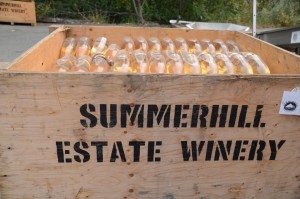 It should be no surprise to find out that Summerhill also received a Certificate of Excellence from Trip Advisor. But of course, and most importantly, the wine was exceptional. In the end I bought a bottle of 1998 Cipes Ariel after sampling it at the winery. The Vancouver Sun has described this as “one of the finest sparkling wines ever made in British Columbia” and I can certainly attest to it being perhaps the finest I have ever tasted.
It should be no surprise to find out that Summerhill also received a Certificate of Excellence from Trip Advisor. But of course, and most importantly, the wine was exceptional. In the end I bought a bottle of 1998 Cipes Ariel after sampling it at the winery. The Vancouver Sun has described this as “one of the finest sparkling wines ever made in British Columbia” and I can certainly attest to it being perhaps the finest I have ever tasted.
Summary
Echoing the words of Richard Bullock, it’s an incredibly exciting time for agriculture in British Columbia. We have enormous potential to continue to grow our agricultural sector in the years ahead both through the direct production of food and, as demonstrated by the two successful examples of innovative and creativity that I highlight above, through developing and offering value added food products and services (including tourism). But as the climate continues to warm as a direct consequence of increased atmospheric loading of greenhouse gases, we have to be careful to ensure that this industry has the capacity to adapt to the changing climate. As this past summer has demonstrated, a warming climate has many potential benefits for British Columbia’s agricultural sector in the short term but, without adequate access to freshwater for irrigation, trouble looms ahead.
Global warming will bring a water storage, not a water shortage problem. Overall precipitation will increase, but it will come in fewer, more extreme events, interspersed between longer periods of little or no precipitation. There will be an increased risk of flooding. The precipitation will be skewed to the winter, with a greater likelihood of rain instead of snow as the century progresses. And summer drought will become more common. There will be lots of water around, but it will come at times when it’s not needed and not at times when it is needed. But with proper foresight, adaptive planning and reservoir management, British Columbia should be well positioned to successfully nurture and sustain its vibrant agricultural sector and communities.
Comments are closed.
Recent Comments
- Marilyn Goode on Global warming: An intergenerational conversation and plea for action
- Mary Kelly on When ideology trumps evidence: The decision to cancel the school liaison officer program in School District 61
- Andrew Weaver on Earth: The final frontier and the failure of fear-based climate messaging
- Russ Q on Earth: The final frontier and the failure of fear-based climate messaging
- Diane Perry on Earth: The final frontier and the failure of fear-based climate messaging

